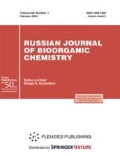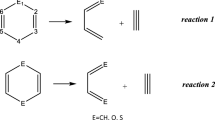Abstract
It has been found that the presence of a free OH group at the 3'-terminal residue of the substituted ethylene glycol fragment in a phosphoryl guanidine oligodeoxyribonucleotide derivative is a factor that determines the instability of the structure of the target oligonucleotide product under the conditions of a standard deblocking protocol. It has been shown that the main by-products of the realization of the anchimeric effect of the OH group are the products of the transesterification of the phosphoryl guanidine (PG) unit carrying the O-substituted ethylene glycol residue. The data of the mass spectrometry analysis indicate that, under alkaline conditions, the accumulation of derivatives devoid of the N,N,N',N'-substituted guanidine residue (1,3-dimethylimidazolidin-2-imine, DMI) or the entire 3'-terminal PG-containing nonnucleotide unit occurs.







Similar content being viewed by others
REFERENCES
Glazier, D.A., Liao, J., Roberts, B.L., Li, X., Yang, K., Stevens, C.M., and Tang, W., Bioconjugate Chem., 2020, vol. 31, pp. 1213–1233. https://doi.org/10.1021/acs.bioconjchem.0c00060
Bennett, C.F., Annu. Rev. Med., 2019, vol. 70, pp. 307–321. https://doi.org/10.1146/annurev-med-041217-010829
Eckstein, F., Nucleic Acid Ther., 2014, vol. 24, pp. 374–387. https://doi.org/10.1089/nat.2014.0506
Rettig, G.R. and Behlke, M.A., Mol. Ther., 2012, vol. 20, pp. 483–512. https://doi.org/10.1038/mt.2011.263
Braasch, D.A. and Corey, D.R., Chem. Biol., 2001, vol. 8, pp. 1–7. https://doi.org/10.1016/S1074-5521(00)00058-2
Nielsen, P.E., Chem. Biodivers., 2010, vol. 7, pp. 786–804. https://doi.org/10.1002/cbdv.201000005
Du, L. and Gatti, R.A., J. Immunol. Methods, 2011, vol. 365, pp. 1–7. https://doi.org/10.1016/j.jim.2010.12.001
Kupryushkin, M.S., Pyshnyi, D.V., and Stetsenko, D.A., Acta Naturae, 2014, vol. 6, pp. 116–118.
Dyudeeva, E.S., Kupryushkin, M.S., Lomzov, A.A., Pyshnaya, I.A., and Pyshnyi, D.V., Russ. J. Bioorg. Chem., 2019, vol. 45, pp. 709–718. https://doi.org/10.1134/S1068162019060153
Pyshnaya, I.A., Lomzov, A.A., and Pyshnyi, D.V., Russ. J. Bioorg. Chem., 2019, vol. 45, pp. 677–683. https://doi.org/10.1134/S1068162019060335
Kor, K., Turner, A., Zarei, K., Atabati, M., Beni, V., and Mak, W.C., Anal. Bioanal. Chem., 2016, vol. 408, pp. 1475–1485. https://doi.org/10.1007/s00216-015-9250-9
Bazhenov, M.A., Shernyukov, A.V., Kupryushkin, M.S., and Pyshnyi, D.V., Russ. J. Bioorg. Chem., 2019, vol. 45, pp. 699–708. https://doi.org/10.1134/S1068162019060074
Stetsenko, D.A., Kupryushkin, M.S., and Pyshnyi, D.V., WO Patent no. WO2016028187A1, 2014.
Pavlova, A.S., Dyudeeva, E.S., Kupryushkin, M.S., Amirkhanov, N.V., Pyshnyi, D.V., and Pyshnaya, I.A., Electrophoresis, 2018, vol. 39, pp. 670–674. https://doi.org/10.1002/elps.201700415
Maiti, M., Michielssens, S., Dyubankova, N., Maiti, M., Lescrinier, E., Ceulemans, A., and Herdewijn, P., Chemistry, 2012, vol. 18, pp. 857–868. https://doi.org/10.1002/chem.201102279
Kupryushkin, M.S., Konevetz, D.A., Vasilyeva, S.V., Kuznetsova, A.S., Stetsenko, D.A., and Pyshnyi, D.V., Nucleosides Nucleotides Nucleic Acids, 2013, vol. 32, pp. 306–319. https://doi.org/10.1002/chem.201102279
Funding
The work on the analysis and implementation of the anchimeric effect was supported by the Russian Foundation for Basic Research (project no. 19-34-90132) and is a continuation of pilot studies on mass spectrometry analysis supported by the Russian Science Foundation in 2019 (project no. 18-14-00357).
Author information
Authors and Affiliations
Corresponding author
Ethics declarations
COMPLIANCE WITH ETHICAL STANDARDS
The paper does not contain any studies involving animal or human participants performed by any of the authors.
Conflict of Interests
The authors declare that there is no conflict of interest.
Additional information
Translated by S. Sidorova
Abbreviations: CPG, controlled-pore glass; DMI, 1,3-dimethylimidazolidin-2-imine, the N,N,N',N'-substituted guanidine residue; ESI MS, electrospray ionization mass spectrometry; NA, nucleic acid; the prefix d (deoxyribo-) is omitted (unless otherwise indicated); ON, oligonucleotide; RPC, reversed-phase chromatography; PG, phosphoryl guanidine unit; PGO, phosphoryl guanidine oligodeoxyribonucleotide.
Rights and permissions
About this article
Cite this article
Dyudeeva, E.S., Pavlova, A.S., Kupryushkin, M.S. et al. Problems of the Synthesis of Oligonucleotide Derivatives in the Realization of the Anchimeric Effect. Russ J Bioorg Chem 47, 505–513 (2021). https://doi.org/10.1134/S1068162021020096
Received:
Revised:
Accepted:
Published:
Issue Date:
DOI: https://doi.org/10.1134/S1068162021020096




